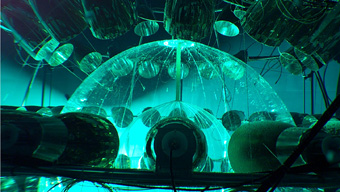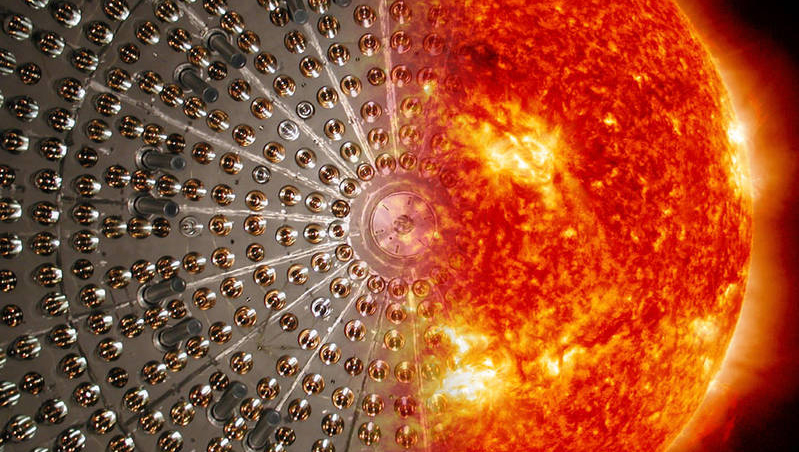Astroparticle Physics
 Investigating solar neutrinos: the Borexino experiment at Gran Sasso, Italy. Photo: Henning Back/Virginia Tech.
From astronomical observations we know today that only 5% of the total energy density is composed of visible matter present in
stars as in the interstellar and intergalactic medium. 70% of the energy density is composed of dark energy, which nature remains
still unraveled. 25% is out of dark matter, which gravitational effects have been observed in the rotation velocity of the
galaxies and on the deviation of light stemming from far away galaxies on their why to us due to the gravitational field caused
by dark matter itself. Also the nature of dark matter remains unknown but there are several predicted candidates as e.g.
WIMPs (Weakly Interacting Massive Particles) which are searched for in many experiments nowadays. Since these particles, which are
not predicted within the Standard Model, do interact only very weakly with normal matter, very big detectors become necessary to
detect the rare collisions of the WIMPs and the atomic nuclei present in the detectors. Furthermore, these measurement are disturbed
by the signals stemming from other processes, as for example cosmic rays reacting in the atmosphere, and hence it is necessary to
perform the experiment deep in the underground as it is the case at the Gran Sasso laboratory.
Investigating solar neutrinos: the Borexino experiment at Gran Sasso, Italy. Photo: Henning Back/Virginia Tech.
From astronomical observations we know today that only 5% of the total energy density is composed of visible matter present in
stars as in the interstellar and intergalactic medium. 70% of the energy density is composed of dark energy, which nature remains
still unraveled. 25% is out of dark matter, which gravitational effects have been observed in the rotation velocity of the
galaxies and on the deviation of light stemming from far away galaxies on their why to us due to the gravitational field caused
by dark matter itself. Also the nature of dark matter remains unknown but there are several predicted candidates as e.g.
WIMPs (Weakly Interacting Massive Particles) which are searched for in many experiments nowadays. Since these particles, which are
not predicted within the Standard Model, do interact only very weakly with normal matter, very big detectors become necessary to
detect the rare collisions of the WIMPs and the atomic nuclei present in the detectors. Furthermore, these measurement are disturbed
by the signals stemming from other processes, as for example cosmic rays reacting in the atmosphere, and hence it is necessary to
perform the experiment deep in the underground as it is the case at the Gran Sasso laboratory.
 Underground Lab Garching. Photo: TUM/Heddergott.
In these underground laboratories also neutrinos, which can appear in the three different flavors: electron-, muon- and tau-, are
studied, since these particles play a key role within astroparticle physics. Very long measurements performed showed that only
about half of the electron-neutrinos emitted from the sun reach the earth, since many of those are transformed on their way into
muon- or tau-neutrinos. This proved that neutrinos have a mass and that physics beyond the Standard model, where neutrinos are
massless, must exist. The exact determination of the neutrinos properties as the mass, the so-called mixing angle among the three
families are the central core of many on-going effort from the side of many experimentalists and theoreticians.
Underground Lab Garching. Photo: TUM/Heddergott.
In these underground laboratories also neutrinos, which can appear in the three different flavors: electron-, muon- and tau-, are
studied, since these particles play a key role within astroparticle physics. Very long measurements performed showed that only
about half of the electron-neutrinos emitted from the sun reach the earth, since many of those are transformed on their way into
muon- or tau-neutrinos. This proved that neutrinos have a mass and that physics beyond the Standard model, where neutrinos are
massless, must exist. The exact determination of the neutrinos properties as the mass, the so-called mixing angle among the three
families are the central core of many on-going effort from the side of many experimentalists and theoreticians.
 The photo composition shows the Borexino detector and the sun. Photo: Borexino Collaboration.
Also, the role played by neutrinos in stellar explosions and in the production of heavy elements during these explosions is one
very important aspect of this scientific branch.
The photo composition shows the Borexino detector and the sun. Photo: Borexino Collaboration.
Also, the role played by neutrinos in stellar explosions and in the production of heavy elements during these explosions is one
very important aspect of this scientific branch.
Other sectors of astroparticle physics deal with the study of high energetic particles coming from the cosmic radiation and short burst of very high-energy gamma radiation, called Gamma Ray bursts, which should stem from the largest explosion in the universe. As for the cosmic radiation, we normally deal there with atomic nuclei with a wide spectrum of mass and energy, which e.g. exceeds by far the energy which can be reached by the largest accelerators on earth.
Research groups: Beneke - Fierlinger - Garbrecht - Ibarra - Oberauer - Ratz - Resconi - Schönert